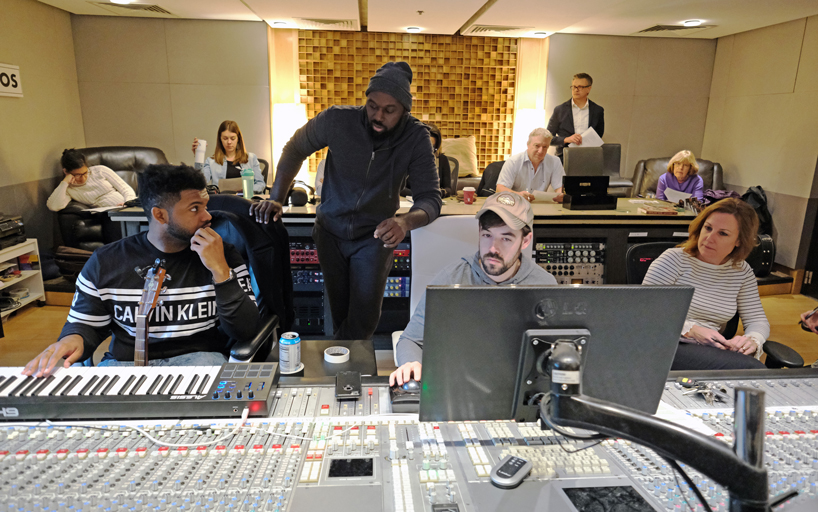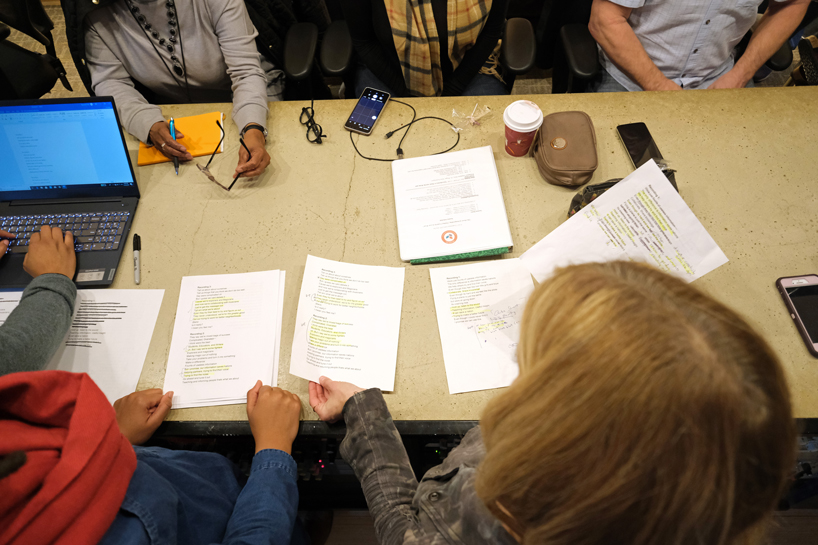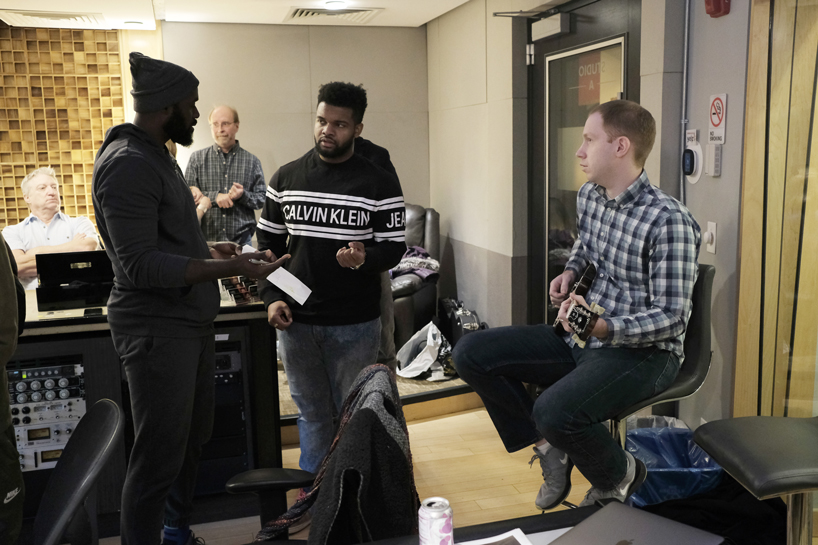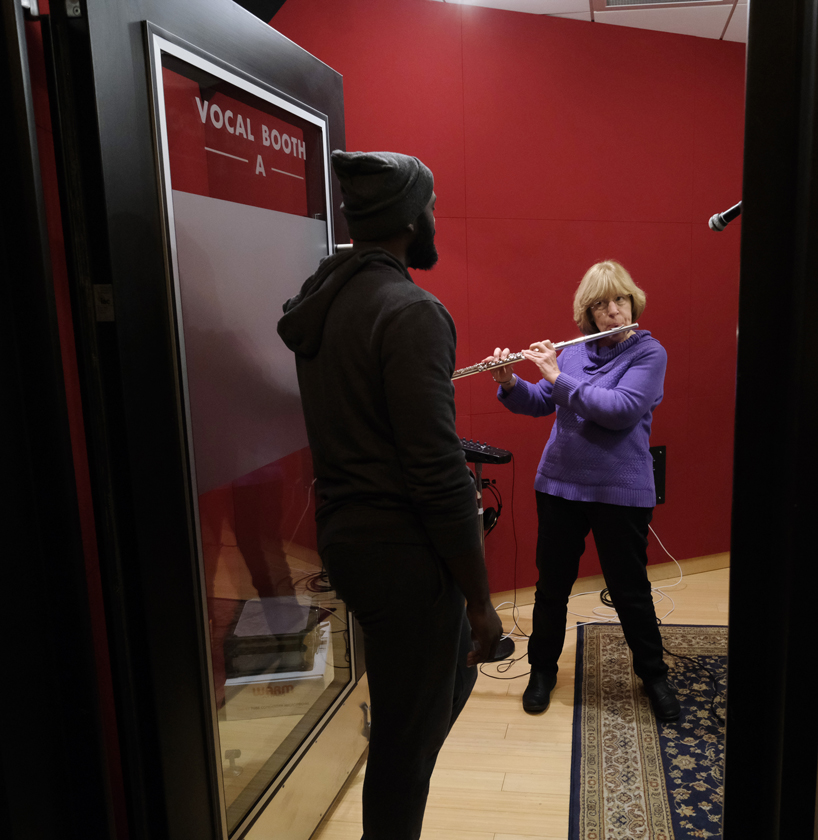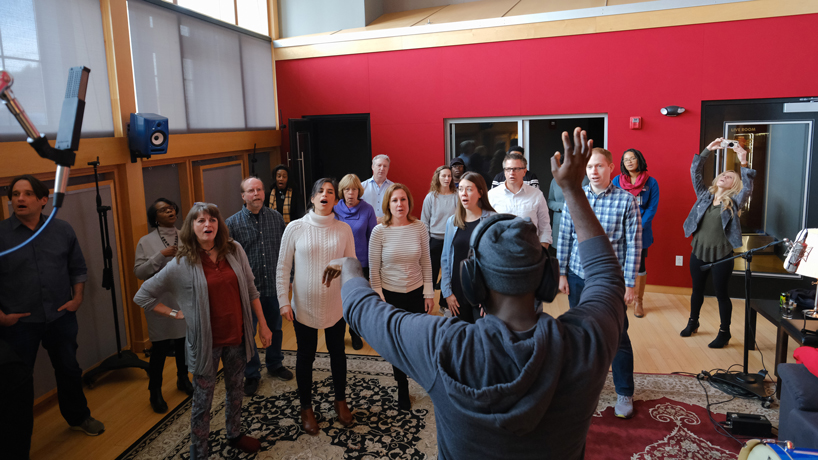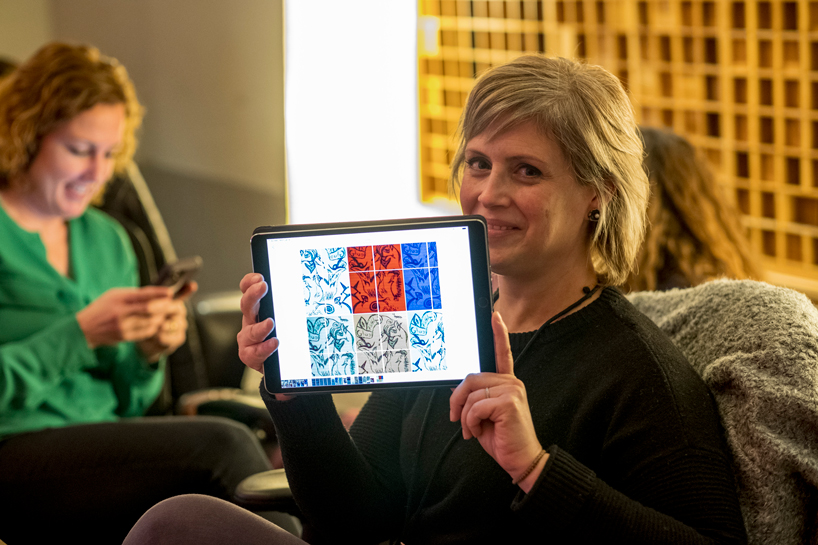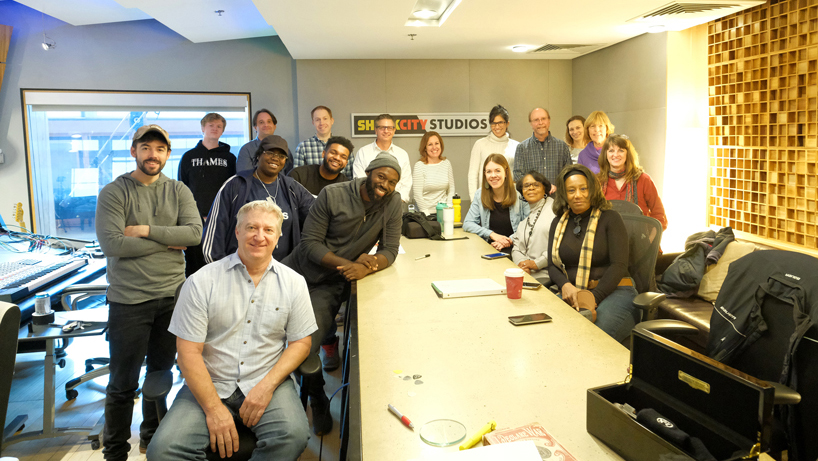
Missouri Institute of Mental Health staff members worked with Brian Owens (center, leaning on the table), the E. Desmond Lee Community Music Artist in Residence, to create a song, “Do Process,” at Shock City Studios through the Scientist Artist Collaborative. (Photos by August Jennewein)
Everyone seemed to lean forward a little in their cushy couch seats, rolling chairs and bar stools spread out around the room, softly lit with a red hue emanating from the indirect lighting overhead.
The anticipation for the moment had been building for more than a month, since the last time the group had all gathered in the same space at Shock City Studios in south St. Louis.
There were researchers and support specialists from every arm of the University of Missouri–St. Louis’ Missouri Institute of Mental Health, and at the center of the room – right behind Shock City head engineer Sam Maul – stood soul singer Brian Owens, the E. Desmond Lee Community Music Artist in Residence.
He was finally ready to unveil a version of a song – nearly completed and titled “Do Process” – that they made together through a program called the Scientist Artist Collaborative.
Brian Owens (standing) works with Joshua “Paco” Lee (left) and engineer Sam Maul (center) to refine a line in the song “Do Process” as MIMH researcher Rachel Kryah (right) looks on.
“All right, here we go,” Owens said as the chatter that filled the room only seconds before ceased.
The sound of piano and a deliberate drum beat quickly broke the silence, and St. Louis-area singer Joanna Serenko’s voice flowed from all corners and overhead.
“We are here not to fear, but to move forward” …
All those present bobbed their heads and tapped their feet to the music.
Owens, usually always fine-tuning when he’s in the studio, resisted the urge to call for any changes long enough to allow the song to play through all the way to the end.
Smiles filled the faces of the audience, and they clapped their hands together when the final note faded out.
Connecting two worlds
“It was amazing,” Rachel Kryah said a few days later when discussing the song. “It was so good.”
Kryah is a principal investigator at MIMH and has more than a decade of experience managing large-scale evaluation projects that assess the effectiveness of prevention and early intervention programs aimed at children and their families.
She has also taken the lead role in organizing the Scientist Artist Collaborative, which just completed its fifth iteration.
“The program connects artists with our principal investigators at MIMH, and the idea is to hopefully facilitate new and creative basic science research programs,” Kryah said. “I think a lot of science often can be really focused and conservative. We get a little guarded, which can slow the scientific process and limit the outcome. Hopefully, this program works to break those barriers and encourage our investigators to engage in a creative process in a more impactful and innovative manner.”
Professor Robert Paul had come up with the idea for the program not long after taking over as the director of MIMH in 2014.
At the time, the institute didn’t have many formal professional development programs targeted at early career faculty members and investigators, something Paul was eager to change.
It was also a period where MIMH was shifting to a self-funded research model, putting increased pressure on investigators to produce innovative grant proposals to secure limited resources in a competitive environment.
The Scientist Artist Collaborative is now one of four professional development programs that MIMH sponsors each year, and it builds on similar ideas of scientists working with artists at the Massachusetts Institute of Technology and the University of California, San Francisco.
Brian Owens (left) and Joshua “Paco” Lee talk with MIMH lead scientist Jacob Bolzenius about a guitar riff before recording at Shock City Studious.
“The way I always understood and framed this and pitched it to our team is, ‘Look, at the end of the day, the worst possible scenario is we’re going to spend some time together and get to know each other,’” Paul said.
The chance to build rapport among colleagues was welcome as it can be easy for investigators to feel siloed while focused on their individual projects in the areas of research, evaluation, professional training and community outreach.
Paul insists the payoffs have gone far beyond team building. The program works to get people out of their comfort zones and teaches them not to be afraid of failing at something they haven’t done before while also instilling in them a sense of creativity that they can apply to their work.“I love the outcomes,” he said. “We have gotten closer, and I do believe that we’ve developed some additional resilience in the process.”
Exploring the creative process
For the first year of the program, MIMH researchers worked with educator, singer and musician Heidi Clare, the Atlantic Fellow at the Global Brain Health Institute and UCSF Memory and Aging Center, who performed in the Lee Theater at the culmination of the program.
Brian Owens talks to Associate Research Professor Elizabeth Sale before recording her on flute at Shock City Studios.
In the years since, the researchers have worked with visual artists and tried their hand at stage acting. This year, they worked with Owens, a 2008 UMSL music alumnus who has created albums such as “Soul of Ferguson,” “Soul of Cash” and “Love Came Down.” Owens has spent four years as the Des Lee Community Music Artist in Residence and has worked with young artists from at LIFE Arts, Inc.
The MIMH staff members met three times with Owens and several of his associates – Stephanie Holly, director of Programs for LIFE Arts, Inc.; LIFE Arts Fellow and music therapy intern Caitlyn Lee; Cynthia Briggs, professor emeritus at Maryville University; Jaime Wilhite-Kennington, owner and director of clinical services at supervision at Music Therapy St. Louis; and FLOW creative artists Joshua “Paco” Lee, Cecil McClendon and Christopher Johnson-Mobley, also an UMSL business student – before going into the studio. The first of those sessions happened Nov. 11 at the MIMH training room.
They started off getting to know each other, and Owens asked them about the role music plays in each of their lives. Eventually, they moved on to talking about the creative process each of them goes through, drawing parallels between songwriting and grant writing.
“This is a good group of creative people,” Owens said. “I don’t think scientists or people who write grants always tend to think of themselves that way, but they’re highly creative.”
He asked them to use that creativity while thinking about the messages they wanted to convey to people about their work.
MIMH researchers, staff members and administrators sing the outro to “Do Process” during a recording session at Shock City Studios.
Owens gathered their ideas on an easel at the center of the room. Those ideas became the foundation for the lyrics that eventually would make up “Do Process,” which he envisioned as an anthem celebrating the impact of MIMH.
Owens and his musical collaborators grouped themes together and tested out phrases while freestyling.
“When we’re writing, we’ll start with a lot of ideas, and then we have to boil it down to something that is consistent and concise that people can understand really quickly,” Owens said. “That’s what a song is. You’re taking complicated concepts, and you’re boiling it down to something that people can actually latch onto.”
They all gathered at Shock City Studios to start the recording process on Nov. 22 with MIMH researchers lending some of their musical talents to the project – to the surprise of colleagues who hadn’t known they existed. Lead scientist Jacob Bolzenius played guitar. Associate Research Professor Elizabeth Sale contributed on flute. Owens also brought in sophomore music major Desiree Jones to play drums.
Rebecca Preston-Campbell holds up the cover art for “Do Process,” created with a sketch she drew during one of the early sessions of the Scientist Artist Collaborative.
He recorded the whole group singing together for what would become the song’s outro.
He brought the MIMH staff members back to the studio on Jan. 6 to hear the song shortly before he finished mastering it. Owens and his team worked over the next month to mix the song. He brought in several of his children to sing the outro as well, and secured Serenko for the first verse and the chorus. Owens sang the second verse, and Christopher Daniel rapped the third one.
“A lot of these things in the song are things we wrote down from that process, just talking about what we do, why we do it and what we want our impact to be,” Bolzenius said. “It’s definitely cool to hear it in a different medium. Sometimes I get almost burnt out on writing and writing because it’s the same medium, so it’s really interesting to hear it in a different voice. It’s really refreshing.”
Now others are getting a chance to hear it too by clicking on the YouTube video below.
The MIMH staff members who contributed to “Do Process” were: Robert Paul, Rachel Kryah, Larry Harmon, Michelle Hill, Rachel Taube, Jeff Noel, Brendolyn Bailey-Burch, Andy Belden, Ed Riedel, Deb Sprague, Rachel Winograd, Jodi Woodruff, Abel Obosi, Rebecca Preston-Campbell, Elizabeth Sale and Jacob Bolzenius.

